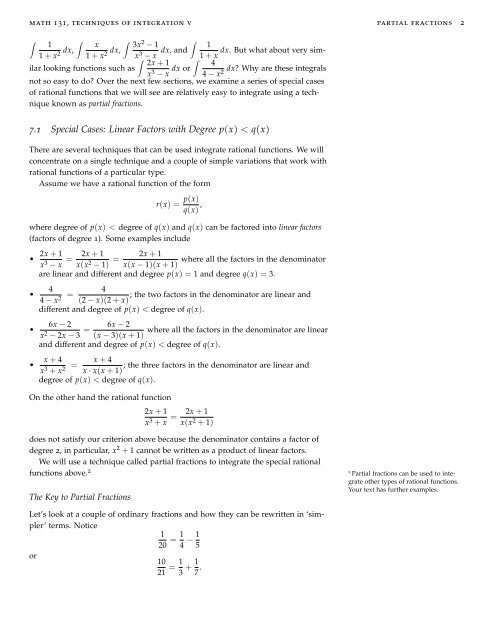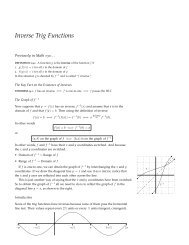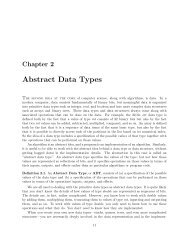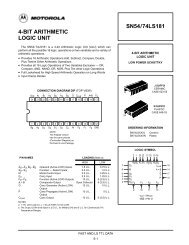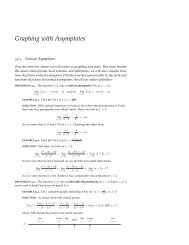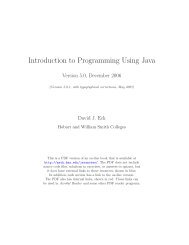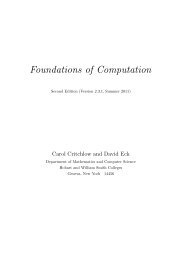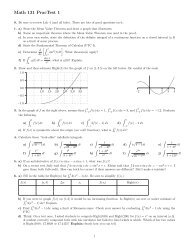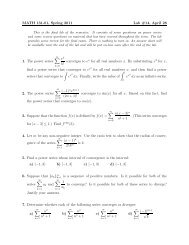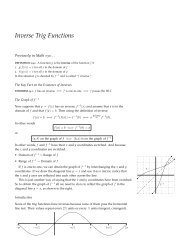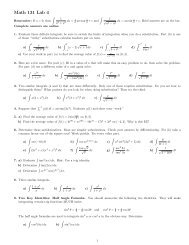Class Notes Day 26 on Partial Fractions
Class Notes Day 26 on Partial Fractions
Class Notes Day 26 on Partial Fractions
You also want an ePaper? Increase the reach of your titles
YUMPU automatically turns print PDFs into web optimized ePapers that Google loves.
math 131, techniques of integrati<strong>on</strong> v partial fracti<strong>on</strong>s 2<br />
∫<br />
∫<br />
∫<br />
1<br />
1 + x 2 dx, x 3x 2 ∫<br />
1 + x 2 dx, − 1<br />
x 3 − x dx, and 1<br />
dx. But what about very similar<br />
looking functi<strong>on</strong>s such as<br />
∫ ∫ 1 + x<br />
2x + 1<br />
x 3 − x dx or 4<br />
dx? Why are these integrals<br />
4 − x2 not so easy to do? Over the next few secti<strong>on</strong>s, we examine a series of special cases<br />
of rati<strong>on</strong>al functi<strong>on</strong>s that we will see are relatively easy to integrate using a technique<br />
known as partial fracti<strong>on</strong>s.<br />
7.1 Special Cases: Linear Factors with Degree p(x) < q(x)<br />
There are several techniques that can be used integrate rati<strong>on</strong>al functi<strong>on</strong>s. We will<br />
c<strong>on</strong>centrate <strong>on</strong> a single technique and a couple of simple variati<strong>on</strong>s that work with<br />
rati<strong>on</strong>al functi<strong>on</strong>s of a particular type.<br />
Assume we have a rati<strong>on</strong>al functi<strong>on</strong> of the form<br />
r(x) = p(x)<br />
q(x) ,<br />
where degree of p(x) < degree of q(x) and q(x) can be factored into linear factors<br />
(factors of degree 1). Some examples include<br />
• 2x + 1<br />
x 3 − x = 2x + 1<br />
x(x 2 − 1) = 2x + 1<br />
where all the factors in the denominator<br />
x(x − 1)(x + 1)<br />
are linear and different and degree p(x) = 1 and degree q(x) = 3.<br />
4<br />
•<br />
4 − x 2 = 4<br />
; the two factors in the denominator are linear and<br />
(2 − x)(2 + x)<br />
different and degree of p(x) < degree of q(x).<br />
6x − 2<br />
•<br />
x 2 − 2x − 3 = 6x − 2<br />
where all the factors in the denominator are linear<br />
(x − 3)(x + 1)<br />
and different and degree of p(x) < degree of q(x).<br />
• x + 4<br />
x 3 + x 2 = x + 4<br />
; the three factors in the denominator are linear and<br />
x · x(x + 1)<br />
degree of p(x) < degree of q(x).<br />
On the other hand the rati<strong>on</strong>al functi<strong>on</strong><br />
2x + 1<br />
x 3 + x = 2x + 1<br />
x(x 2 + 1)<br />
does not satisfy our criteri<strong>on</strong> above because the denominator c<strong>on</strong>tains a factor of<br />
degree 2, in particular, x 2 + 1 cannot be written as a product of linear factors.<br />
We will use a technique called partial fracti<strong>on</strong>s to integrate the special rati<strong>on</strong>al<br />
functi<strong>on</strong>s above. 2<br />
The Key to <strong>Partial</strong> Fracti<strong>on</strong>s<br />
2 <strong>Partial</strong> fracti<strong>on</strong>s can be used to integrate<br />
other types of rati<strong>on</strong>al functi<strong>on</strong>s.<br />
Your text has further examples.<br />
Let’s look at a couple of ordinary fracti<strong>on</strong>s and how they can be rewritten in ‘simpler’<br />
terms. Notice<br />
1<br />
20 = 1 4 − 1 5<br />
or<br />
10<br />
21 = 1 3 + 1 7 .


